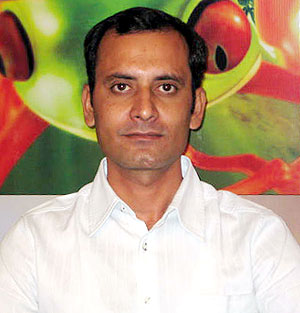 Satyajeet, there are many an animation industry veteran who will envy the kind of depth and breadth of experience that you have had in various roles in this industry. We would love you to share some of the milestones of your career?
Satyajeet, there are many an animation industry veteran who will envy the kind of depth and breadth of experience that you have had in various roles in this industry. We would love you to share some of the milestones of your career?
Envy! Huh…I was lucky enough to start my career very early back in 1998 and was driven to make a mark in this segment. I started my 1st job with Penta Four as an animator and in very quick time founded a company called MUV STUDIO and INSTITUTE. (2000 March). I handled all the company formation, recruitments, training the core team, day to day management to marketing and sales strategies, managing the production, setting up a robust production pip-line, delivering the quality production, interacting and guiding the creative team from USA to international marketing and sales.
3D Animation and technology was going through a rapid change that time and we had an acute shortage of qualified manpower therefore the 1st thing I decided was to create a core team and give them the best exposure by industry experts from USA and other parts of the world. To bridge the gap we had started our own training school MIDA in 2000. We were the 1st authorized training centre for Alias Wave-front in India.
Well in terms of milestones we have passed many animation tests and done lots of service work for companies like Disney, Warner brothers, MGM to name a few.
I have finalized and done a couple of co-productions as well. We chose to start our own IP in 2002 (very early in the Indian context) and I have engaged western talent to do pre-production, music and post-production with the final design, layout, most of the story boarding and production being done in India.
We were the 1st company from India to produce a 3d animated direct to home video feature, (Called “kiddo The Super Truck”) that was a true marriage between East (India) and West (USA). I sold that property to 33 countries and it is still generating revenue.
 I am a dreamer and entrepreneur so it was satisfying to produce something which was on par with western quality. Our product had been showcased in Licensing show Las-Vegas and well appreciated. (2004)
I am a dreamer and entrepreneur so it was satisfying to produce something which was on par with western quality. Our product had been showcased in Licensing show Las-Vegas and well appreciated. (2004)
With my boss I started the Animation reporter magazine (2002) with a very noble idea to put across animation industry concerns.
We would love to know about your focus and goals with your role at DSK Supinfocomm?
I have always dreamt that we (India) should have full time quality animation training schools where focus is given on teaching and grooming the students rather than creating a technician due to market demand and necessity. It is the best thing for budding aspirant animators to have a choice in India whereby they can learn full time animation techniques, aesthetics & technology and become a part of the industry with holistic knowledge.
My focus is to make my Chairman H. D.Kulkarni and CEO Umesh Tashildar‘s vision come true which is “to make DSK Supinfocom the best animation training school in the world and provide the best brains to the industry”.
We train our students to work on film projects from the conception stage to final post-production. Students with aptitude for character design, animation, storyboard, lighting etc. are encouraged to develop their skills. Mandatory internships in the course of their studies give them the experience of working in a professional environment and the final diploma film obliges them to learn teamwork, an essential aspect of any film production.
As more and more studios in India will venture out into original content production, our graduates should logically find interesting creative lead positions.
Those who choose to work for foreign clients will have artists and technicians familiar with Western culture and aesthetics.
 Could you share some of the highs and pains you experienced with CCX? What advice do you have for studios and professionals who are traveling a similar journey?
Could you share some of the highs and pains you experienced with CCX? What advice do you have for studios and professionals who are traveling a similar journey?
Well being an entrepreneur is a progression and it varies from person to person depending on what one sees himself or herself as!
I am passionate about creating something and doing things the way I want. I had gone through 6 years of learning and working experience before I could start my own business. In India it is very hard for a first gen-entrepreneur to start and sustain a business because all businesses have a cycle and to get the ROI in animation generally one needs to be very patient.
I enjoyed the freedom, challenges and handling the show on my own. We did many out source work at CCX Studio and imparted good real time teaching to the students at our CCX Academy. It was a great mix between me and Siju Thomas. (Both of us had started CCX STUDIO)
The decision to sell CCX was taken due to market force, however that‘s the part of the business where acquisitions, mergers and sales are the basic norms.
My advice! We should understand the market dynamics. What we intend to produce, for whom and where we are distributing… all has to be well planned and targeted before you start something.
So when did you actually begin in the animation industry, what has changed since those days and what remains the same?
I started in 1998 with Power animator on SGI with UNIX platform and dos version of max and over a period of time technology has changed the realm of life, something which was impossible in those days has become a cake walk today.
The animation industry has experienced very rapid growth in India in the last eight years. Today you have very enhanced graphics cards, powerful software, great work stations and all the brilliance of the technology which is awesome. What have not changed are the process and a skilled professional. To drive a formula one you need to be a good driver therefore one needs to be skillful to get the best result from these innovations. As far as industry is concerned, at that time India didn‘t have much position in the animation space whereas now we have a proven track record and are considered a serious player.
Are there any things related to the Indian animation industry that you feel strongly about and want to share with our industry readers?
It is a question of knowing the art. Art means the display of intellectual energy.
Everywhere we can see intelligence in everything if we develop the art of looking from the artistic point.
We as an Animation industry have done and are doing service works & co productions. Some of the studios have started producing their own Tv-Series and feature Films.
Let‘s do some fact finding,
Intellectual property: Different studios have ventured into this domain; creating original content for either the domestic market, or even for the global market.
The domestic market: Krayon Studios has produced a feature animated film with original content. Other examples were Roadside Romeo from Tata Elxsi, soon to be released Arjun, from UTV and Tata Elxsi. We are eagerly waiting for Crest Animation and Lionsgate‘s Alpha and Omega. Everybody knows about Big Animation‘s successful Little Krishna TV series.
Television and especially internet are changing the public‘s viewing habits world-wide.
What we don‘t yet have, is a box-office success of an Indian production on the Indian market.
Because of this, both producers and distributors are shy of investing in Indian animated features.
The global market: When we speak of the global market, we speak of animation which crosses frontiers and is widely distributed. When it comes to features, this is essentially American, occasionally Japanese.
When it comes to TV, it is essentially European, Canadian and Japanese. The Japanese have managed to impose their style and their cultural values to an international public, even though we must be careful. There is a variety of Japanese productions which never make it abroad.
80% of the global audiovisual market is Hollywood based. Some countries have managed to resist better than others due to the vitality of their home film industries, India being foremost. However, this has not been matched or even approached by the animation industry.
The European and Japanese productions occupy niche markets, a more artistic approach, smaller budgets, satisfying their financial needs by a more restricted but adult public of connoisseurs. Other, smaller countries who have adopted this model, ally themselves with Europe and Japan through co-production and distribution agreements.
Domains of application: Feature film production, animated series, video-games, or animation in commercials are the visible part of the iceberg. Today, some form of animation or animation-based simulation is present in every sector of communication.
Pharmaceutical companies, Architects, urban developers, car-manufacturers, machine manufacturers, power companies… all use some form of animation to instruct, convince, and more generally to communicate.
Back in the film sector: animation is a tool often used in non-animated films. The whole sector known as pre-visualization or pre-viz consists of planning complicated film sequences visualized as mock-ups using animation and light video techniques. This ranges from action sequences to crowd movements.
How does the animation industry function abroad?
First, just a reminder: Everywhere that animation exists it is considered as part of the audio-visual industry.
It is considered exactly the same as live-action film, but with a greater implication of modern technology.
In India, this is not yet clearly determined. Animation and gaming are still attached to the IT industry. Only the outsourcing “factory” aspect is really taken into consideration.
What is the role of government subsidies in the form of tax incentives?
This is the crux of the economic war. Some countries use subsidies and/or screening quotas to protect a small, otherwise unprofitable sector for both cultural and economic reasons. Now, these systems are far from perfect and are often criticized even from within.
Nevertheless, they have proven their efficiency to a large extent in Great Britain, France, Germany, Canada, Israel, and Korea, albeit in very different ways.
We need a regulation whereby one or two hour animated content shown by TV channels has to be a locally developed content. (China has this rule).
Government should provide a working capital fund for animation studios and India should have a co-production treaty with USA, Canada and other European countries to boost up our industry.
Can you share some of your goals, dreams and ambitions related to you and the animation space?
My goal is to make full length 3D animated feature film and a live action feature for a global audience.
One of my dreams is to set up a quality studio which produces its own IP for the global audience. A good story with amazing visual stylization!